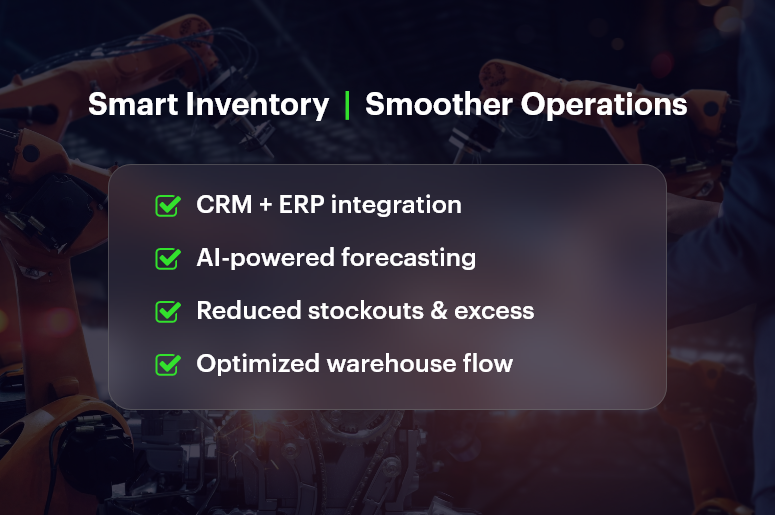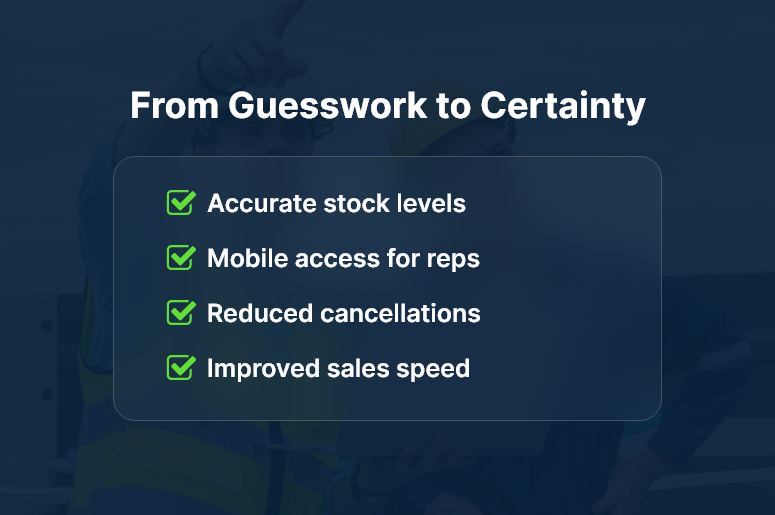In today’s fast-paced manufacturing world, demand shifts in days, not months. According to McKinsey, manufacturers that leverage inventory automation can reduce stockouts by up to 30% and lower carrying costs by 20–50%. For growing manufacturers, the challenge isn’t just producing more — it’s producing smartly.
If your team still juggles spreadsheets, manual counts, and siloed tools, you’re at risk of lost sales, delayed orders, and rising costs. The good news? Automating inventory to meet demand is not only possible, it’s surprisingly achievable with the right CRM + ERP integration.
In this post, we’ll explore why inventory automation matters, the best practices for implementation, and how CRMLeaf can be your trusted partner in scaling your operations.
Why Automating Inventory to Meet Demand is Critical for Growth
For small and mid-sized manufacturers, manual inventory management often works — until it doesn’t. As demand scales, so do the complexities.
Here’s why it matters:
- Accuracy drives trust – Sales and operations need real-time inventory visibility to prevent overselling or production delays.
- Speed impacts customer experience – Faster order fulfillment builds customer loyalty.
- Cost control is essential – Overstock ties up capital; stockouts cost sales.
- Integration fuels productivity – Linking your CRM and ERP eliminates double entry and reduces human error.
Industries Feeling the Pressure:
- Food & Beverage Manufacturing – Short shelf life means timing is everything.
- Automotive Parts – Demand spikes during seasonal service cycles.
- Consumer Electronics – Rapid product turnover demands agile stock control.
Without inventory automation, these industries face bottlenecks that slow growth and frustrate customers. With it, they achieve seamless supply chain optimization.

Best Practices to Automate Inventory and Meet Demand
Here’s how growing manufacturers can make it happen:
1. Integrate Your CRM and ERP
- Eliminate data silos between sales, production, and finance.
- Give teams a single source of truth for stock control and demand forecasts.
- Example: Sales sees real-time stock levels, while operations sees confirmed orders instantly.
2. Use Real-Time Inventory Tracking Systems
- Deploy inventory management software with barcode/RFID scanning.
- Update inventory counts instantly when goods are received, produced, or shipped.
- Benefit: Reduce human error by up to 90% compared to manual entry.
3. Implement Demand Forecasting Tools
- Use historical sales data, market trends, and seasonal patterns to forecast demand.
- Adjust production schedules automatically to avoid overstock or stockouts.
- CRMLeaf’s analytics module offers AI-driven forecasting.
4. Automate Reorder Points
- Set minimum stock levels that trigger purchase orders automatically.
- Avoid last-minute scrambles with supplier integration.
- Benefit: Smoother production planning and improved supplier relationships.
5. Optimize Warehouse Layout & Processes
- Use warehouse management systems (WMS) to streamline picking, packing, and shipping.
- Map high-demand items closer to packing stations for speed.
- Incorporate FIFO/LIFO rules for better inventory turnover.
6. Connect Inventory Data to Financial Planning
- Inventory cost reduction comes from linking purchasing, sales, and finance data.
- Track carrying costs, shrinkage, and write-offs in real time.
- Build more accurate budgets and forecasts.
7. Train Teams for Tech Adoption
- Even the best inventory tracking systems fail without adoption.
- Provide hands-on training and process documentation.
- Celebrate quick wins to build momentum.
Customer Success Story
A mid-sized automotive parts manufacturer, implemented CRMLeaf’s inventory automation and CRM + ERP integration. Within six months, they achieved:
- 25% faster order fulfillment
- 30% reduction in excess stock
- 15% increase in customer satisfaction scores
They attributed their success to real-time visibility, automated reorder points, and the elimination of manual data entry.
Key Takeaways: Why You Should Automate Inventory to Meet Demand
Automating inventory isn’t just about tech — it’s about aligning sales, operations, and finance so they work from the same playbook.
Remember:
- Real-time visibility means fewer mistakes and happier customers.
- Automation slashes manual effort and speeds up decision-making.
- CRM + ERP integration creates a unified, growth-ready operation.
Bullet Points Recap:
- Reduce stockouts and overstock issues.
- Improve order fulfillment speed.
- Gain accurate demand forecasting.
- Free up cash by reducing excess inventory.
- Improve cross-department collaboration.


